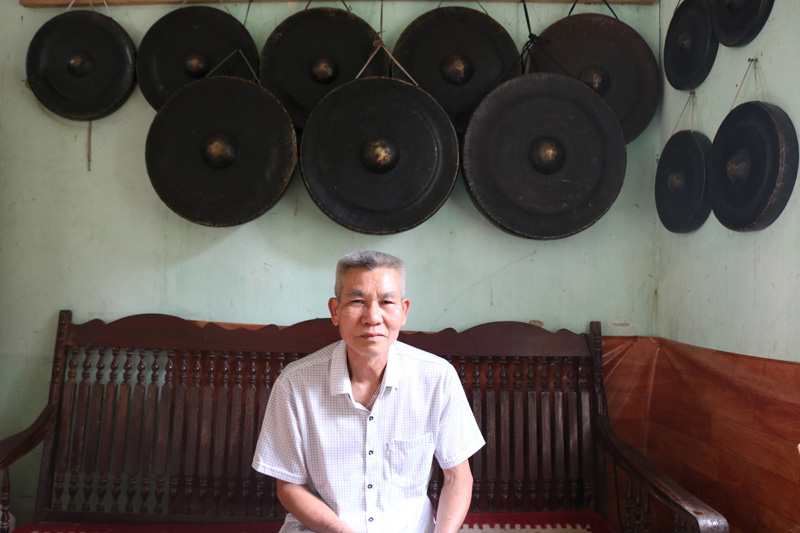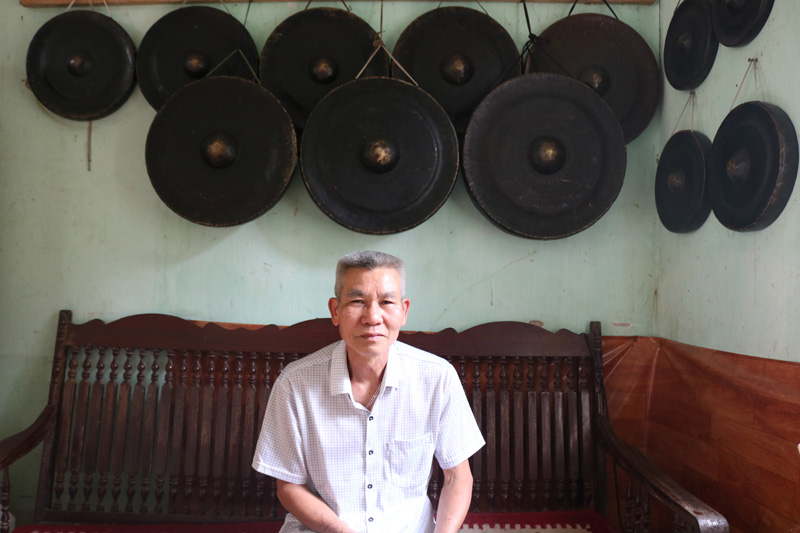
(HBO) - For many generations, gong has become an indispensable part of the spiritual life of the Muong ethnic group. Being one of the few people living in Hoa Binh City, who owns the Muong ethnic gongs, Mr. Dinh Van Nien (Moi Mit village - Yen Mong commune) always respects and preserves the precious gong set of his family.

The Muong ethnic gong set - the pride of Mr.
Dinh Van Nien is always being placed in the most prominent position and most
visible in the house.
Although being passionate about gongs since
he was very small but in 1994, when he became a cultural officer of Yen Mong
commune, Mr. Nien was able to collect and buy Muong ethnic gongs. On his
working days in the commune, he began to save a part of his salary to buy
gongs. Having done continuously in 15 years, in 2009, his gong set was full of
12 pieces.
Previously, he loved to play and watch
playing gongs. He did not have one at his home, so he had to borrow from the
women in the village. Every time there is a need, he had to go around the village
to borrow a few gongs for playing. Borrowing for a long time made him so
embarrassed; he bravely bought the gongs for his own. At that time, his commune
staff salary was only about 500,000 VND / month. He had to feed the family,
support for the children’s study,he had to save every change to have enough
money to buy each gong. Most of these gongs were bought from Thanh Hoa, Ha Nam
and some other places. A set of gongs can have 7 or 9 pieces but the standard
set of Muong ethnic group must be 12 pieces resembling for 12 months of the
year. Each gong carries a different sound. Despite difficulties, he still tried
to buy a set of 12 pieces because "12 months to make a new year, 12
different sounds to create a piece of Muong ethnic music."
Since his family had gongs, at festivals or
cultural exchanges events, he has lent them to the women in the local. Mr. Nien
said: "In 2015, Yen Mong commune received the title of the new rural
standardized commune. His gong set, together with gongs from other households were
up to 50 gongs, were performed by the art team at the ceremony. Especially, on
the occasion of the 55th Anniversary of Uncle Ho's visit to the Hoa Binh Youth
Vocational School, the gong team of the commune was honored to contribute
special performance, contributing to the opening ceremony of the Relics Area
more exciting and deep of ethnic culture. The gong has been displayed in his
house for many years and he considers it as a member of the family, an integral
part of his life."
With an increasingly vibrant and widespread emulation movement aimed at building cultured residential areas and cultured families, Yen Thuy District has been making steady progress toward improving both the material and spiritual well-being of its people, while fostering a civilized, prosperous, beautiful, and progressive community.
Once lacking recreational spaces and community facilities, Residential Group 2 in Quynh Lam Ward (Hoa Binh City) has recently received attention for the construction of a new, spacious, and fully equipped cultural house. The project followed the model of state support combined with public contributions in both labor and funding.
The "All people unite to build cultural life" movement, which has been effectively integrated with Kim Boi district’s socio-economic development goals, is fostering a lively spirit of emulation across local residential areas, hamlets, villages, public agencies, and enterprises. In addition, through the initiative, traditional cultural values are being preserved and promoted, while community solidarity and mutual support in poverty reduction and economic development are being strengthened.
A working delegation of the Hoa Binh provincial People’s Committee led by its Permanent Vice Chairman Nguyen Van Toan on June 11 inspected the progress of a project to build the Mo Muong Cultural Heritage Conservation Space linked to tourism services in Hop Phong commune, Cao Phong district.
Born and growing in the heroic land of Muong Dong, Dinh Thi Kieu Dung, a resident in Bo town of Kim Boi district, in her childhood was nurtured by the sweet lullabies of her grandmother and mother. These melodies deeply imprinted on her soul, becoming an inseparable part of her love for her ethnic group's culture. For over 20 years, this love for her hometown has driven Dung to research, collect, and pass down the cultural values of the Muong people to future generations.
In the final days of May, the Ethnic Art Troupe of Hoa Binh Province organized performances to serve the people in remote, mountainous, and particularly disadvantaged areas within the province. These were not just ordinary artistic shows, but they were the meaningful journeys aimed at spreading cultural values, enhancing the spiritual life of the people and contributing to the preservation of ethnic minority cultural identities.



